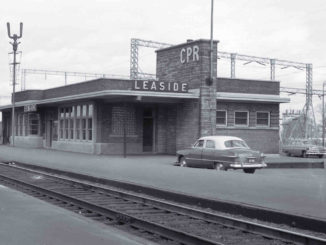 “It was a milestone in Canadian history,” says Drew Hamblin of Sutherland Drive, “the first time the four Canadian divisions fought together as a single unit, and the day Canada stopped being a colony and became a nation in the eyes of the world.”
“It was a milestone in Canadian history,” says Drew Hamblin of Sutherland Drive, “the first time the four Canadian divisions fought together as a single unit, and the day Canada stopped being a colony and became a nation in the eyes of the world.”
The Battle of Vimy Ridge was fought 100 years ago next month, on the morning of April 9, 1917 – Easter Monday. And Hamblin knows far more than most about the day “when Canada came of age.” He’s read the books and is familiar with the manuscripts, films and other sources. But the battle is of more than academic interest to Hamblin; there’s a personal connection, too.
Hamblin’s grandfather, Frank Edgar Hamblin (1897-1988), served in the First World War and fought that day at Vimy Ridge. And while many veterans of his grandfather’s generation were famously reticent to talk about their wartime experiences even to their own family members and often took their tales with them to the grave, Frank Hamblin opened up to his young grandson.
“I’m one of the few people living who have heard a first-hand account of World War One and of Vimy in particular,” says Hamblin. “My grandfather and I would talk all the time, at my parents’ house or my grandparents’ apartment – we connected. I was unrelenting in asking him questions. And he would open up to me, maybe because, as a little kid, I would listen to him without any judgment.”
The elder Hamblin was born in England in 1897, the youngest of four children whose parents were both dead by the time he was nine years old. Taken into the care of the Barnardo organization that helped orphans and homeless children, Frank was separated from his two brothers and sister, shipped to Canada in 1911, and ended up on a potato farm in rural New Brunswick.
He enlisted as soon as he could, in 1915, shipped out to England for training on June 28, 1916, and made it to France on November 29, 1916, just as the preparations for the spring offensive that included the Battle of Vimy Ridge were getting underway.
“He told me he once saw the Red Baron flying overhead,” says Hamblin of his grandfather. “He talked about the maze of trenches and tunnels all along the Canadian front, and living in those muddy, filthy, rat-infested and lice-infested trenches week after week throughout the record cold winter of 1916-17. And he talked about the incredible noise of the artillery bombardment that marked the opening of the battle at dawn on April 9th. No one had ever heard or felt anything like that before in history.”
By then the Germans had held the ridge for two and a half years and it was considered impregnable. French forces had tried to take it back unsuccessfully for more than a year, suffering 150,000 casualties in the process.
In 1916, British forces led by General Sir Julian Byng (who later, as Viscount Byng of Vimy served as Governor General of Canada) relieved the French and began preparations for the 1917 offensive. He was assisted by Major-General Arthur Currie, the highest-ranking Canadian officer, and the two made a good team. Both deplored the excessive casualties resulting from military attitudes that viewed soldiers as so much cannon-fodder in a war of attrition. Both were determined to learn from past mistakes, incorporate Canadian innovations that had been shunned by the more hide-bound British command, and to prevent unnecessary loss of life. The planning, preparation and training were meticulous.

And following the largest artillery barrage in history that began at 5:30 a.m. on April 9th, the Canadians captured most of the ridge by later in the same day. The stunned Germans retreated and by April 12th, the Canadians were in complete control of the ridge, having suffered just 10,602 casualties including 3,598 killed. It was an important military victory that has loomed even larger in light of its later impact on Canadian nationalism.
Frank Hamblin survived Vimy, of course, only to be injured at Passchendaele later in the year. Unbeknownst to him, both his brothers, with whom he had had no contact since separating from them, served in the British Army and were killed in the war. Frank returned to New Brunswick and married, re-enlisted during the Second World War, and ran an internment camp for German POWs in Sherbrooke, Quebec. He eventually moved his family to Toronto, where in the last years of his life he passed on his stories to grandson Drew.
Drew Hamblin, who has his commercial pilot’s licence and manages private planes for a living, is eager to share his own interest in Vimy with others. He’s on the board of the Vimy Foundation, whose mission is “to preserve and promote Canada’s First World War legacy as symbolized with the victory at Vimy Ridge in April 1917, a milestone where Canada came of age and was then recognized on the world stage.”
“Canada is awful at honouring our legacy,” says Hamblin. “The Australians and New Zealanders have ANZAC Day, but we don’t have a Vimy Day – April 9th should be recognized as Vimy Day. The foundation has also been fundraising to build the Vimy Visitors Education Centre at the site of the Vimy Memorial in France. It will be open in time for the anniversary in April.”
The Hamblin family will be there. Drew and his wife Erika, along with Paige (10) and Jack (7) are travelling to France later this month to tour the battlegrounds and museums, and will participate in the commemorations of the 100th anniversary at the Vimy Memorial on April 9th.

What advice does Hamblin have for anyone interested in Vimy Ridge? “Visit the Vimy Memorial in France – it’s stunning – and the new Education Centre. And read Pierre Berton’s book Vimy – it’s pretty good. And visit the Vimy Foundation website www.vimyfoundation.ca. There’s lots of good information and resources there.”
Just as importantly: “Talk to your grandparents or others of the older generations while you can, and get their stories – because they’re amazing!” He adds, only partly tongue-in-cheek: “No one walks to school 20 miles in the snow anymore.”
Do you have personal stories to share about Vimy? Know of someone who fought at Vimy Ridge? What does Vimy mean to you? Share your memories with Leaside Life and we will publish them in our April issue.




